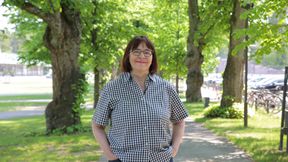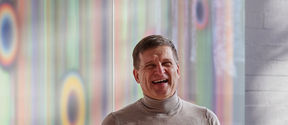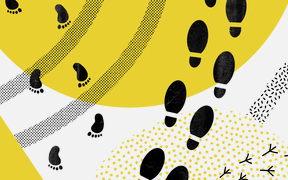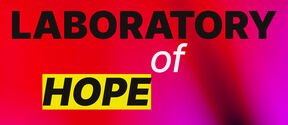Maija Taka: I want to plan the route in advance
'I have a background in geographical research, and I always have to have a map. I need to know where I'm going and why, at what pace and with whom.'

I started in 1988 in the information services of the Helsinki University of Technology (HUT) library. The purpose of the information services was to serve researchers and students. At that time, we didn’t have the tools we have today. We had fax and telephone, which the information service used for communication.
A couple of years before I started, the library services got microcomputers, but there weren't enough communication lines. People went to the basement to change the line switch to their own office when connections to the outside world were needed. Telephone wires were then a tool that connected people, even all the way to America. Even though long-distance calls were very expensive, we were actively in touch with the world.
HUT was a vantage point to the world. It was a place for knowledge. The 90s were marked especially by change. This was visible, for example, in the development of technology. In the 1990s, technology changed continuously until the Internet came along. I remember that HUT was very enthusiastic about it. We always had the spirit of trying new technologies.
It is significant that at the time of the advent of the Internet, the ‘Finland as an Information Society’ programme was also born. In Finland, the principle was that everyone could freely come to the library. We had a unique database system from which we could access the research of the American scientific world. The database provided brief references and an abstract, which was printed out and reviewed by researchers. The research article was obtained through remote service by fax to the researcher. In this way, we knew very well where the world was going at the time.
Requests for database entities were then called ‘online searches’. Online searches to America all cost money at the time. These searches therefore had to be well thought-out, with specific search strategies. Usually, the researcher also had to be on-site. That way, they could immediately tell if the search was going in the wrong direction.
This lasted until the mid-90s, when electronic magazines became available to the world. It was a big change for the library, because previously the library had owned the material it purchased. The biggest challenge was how to communicate the change to users and decide what stand the library would take, because we wanted the library to remain a space which is open and accessible to everyone. It was a big step. When the rate of change accelerates, the biggest challenge is to find the means to keep up. Is there even time to sigh?
Information services has offered students courses on searching for information since the 1970s. We strive to ensure that the students have the best knowledge of how to search for information. I remember in the 90s, we had a trainee called ‘summer-engineer student’ who created Finland's first library websites, and you could browse the website in public spaces on a graphical screen.

Yes, there was indeed. At the time of the ‘Finland as an Information Society’ programme, we had display screens in the public areas which people could use to browse online magazines. It was important that everyone had equal access to information. Everyone had the freedom to read what they wanted and search for information online. We also didn't ask where the library's customers came from.
One day, strange figures in trench coats caught my eye. The characters asked what some customers were searching and whether it was possible to trace which pages had been visited at any given time. They were clearly after someone and wanted to know what information they’d been looking for.
At the time, the library’s technology offered a unique channel for researching information. Because our library adheres to democratic values, such as the freedom of information and the right to privacy, we were unable to disclose the information requested. At that time, it was not even possible to retrieve browsing data retrospectively. During Rector Hyyppä's time in the early 90s, Reuters donated a news screen to the library. It showed stock prices in real time. As a result, a completely new type of customer appeared, a bit more stock market oriented. I remember when we had to set an hour's usage limit for computers in public areas to avoid a rush.
Before Aalto, the library was a separate institution. In the 1990s, I became the office manager of the Information Services unit. I was more involved in administrative tasks and gained insight into how the library was managed and how it fit into the context of the entire university. We were a flat collegial organization, so I was also one of the information specialists. As an engineer, I wanted to know how everything worked in practice. That also kept me on top of my unit's affairs.
I was also involved in the transition to electronic material in the early 2000s. That's when the national electronic library FinELib was born, which still operates today. As a result, libraries centrally agree on licences according to the consortium model. I was also involved in several national working groups that discussed the development of information services. I was at the vantage point of change.

It's been exciting when we’ve done something for the very first time. For example, in the 2000s, there was discussion about how to develop analytics related to publications, visibility and impact measurement, (i.e., metrics). At that time, there was the idea that the three universities would merge into Aalto University, so assessing their research activities and the potential of the new university made sense. The information service of HUT took on the task of analysing publications. It was a showcase for us. Combining the publications and data of researchers from three different universities into a common database was a major task – the entire unit was involved. It was an awesome exercise! We showed that we could handle it and get the job done.
You have to be curious. If I don't know something, then I'll find it out. I think that's the core of being an information specialist. I believe that I can do things that feel good to me. Curiosity is an asset.
When Aalto was founded, there was a change in the hierarchy. It went from distant, unfamiliar titles to being able to contact colleagues without looking at the organizational chart. The sense of community at Aalto is reflected in the fact that it’s easier to approach people. In the very early days, people laughed at the fact that the use of the word 'administration' was banned. But I think that reflected a desire to let go of the ivory tower, where the leadership is isolated from the rest of the community.
Aalto is about trying to find solutions together and having a positive attitude towards the future. Aalto believes in the power of education, science and research. Behind that is a noble desire to drive humanity forward. I hope that desire will continue in our future. In library work, we want to be involved in doing good for society. Our goals are based on providing a benefit to the public.
Interview and text: Meeri Saltevo

'I have a background in geographical research, and I always have to have a map. I need to know where I'm going and why, at what pace and with whom.'

'It’s really important to me personally that we value each other. I believe in that very strongly. The way you treat other people determines the culture of an organisation. We accomplish a lot more when we have respectful interactions.'

'I came with a lot of energy and a lot of willingness to do different things and integrate, but also, the winter was coming. Even though I like new experiences, it was not always easy to arrive in the moment when every day was a little bit darker.'
Inspired by the saying that you should walk a mile in someone’s shoes to understand them, the ‘Walk in my shoes’ series aims to share some of the experiences, thoughts, perspectives and challenges faced by members of the Aalto community.




